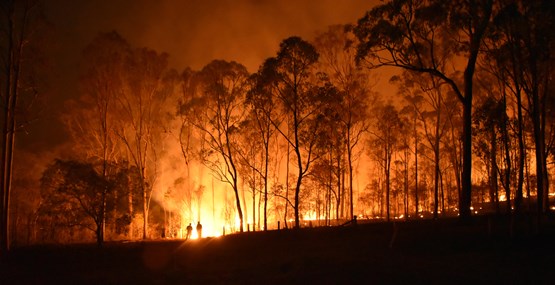Although media coverage of the latest landmark review of climate change science conducted by the Intergovernmental Panel on Climate Change (IPCC) has been understandably muted in light of the alarming situation in Ukraine, its findings are a reminder of the scale of climate risk societies are dealing with.
The analysis, conducted by 270 scientists from 67 countries, concluded that climate change and the resulting extreme weather has caused “widespread adverse impacts”, damaging nature and people, with the most vulnerable communities and landscapes disproportionately affected.
This report follows last year’s assessment of the physical science base and considers what rising global temperatures for human society and the natural world.

Credit: iStock.com/Philips
UN Secretary-General António Guterres has called these findings “unequivocal” – describing the report as an “atlas of human suffering and a damning indictment of failed climate leadership. I have seen many scientific reports in my time, but nothing like this.”
Perhaps the most concerning finding is that the IPCC now forecasts that the most severe impacts of climate change would occur at a lower level of temperature rise than had been predicted when this analysis was last conducted in 2014.
The report concludes that current development trends do not support societal resilience to climate change and also emphasises that the scope to implement climate resilient development is limited if there is not rapid action to reduce greenhouse gas emissions.
Scope of global exposure to climate risk
The report forecasts that between 3.3bn and 3.6bn people currently live in circumstances that make them highly vulnerable to climate change. It also finds that unsustainable development patterns risk that number increasing.
The most vulnerable regions include West Central and East Africa, South Asia, Central and South America, Small Island Developing States and the Arctic.
- In the most vulnerable areas, mortality rates from floods, draughts and storms were up to 15 times higher than in other regions.
- A high number of species are vulnerable and the level of human and ecosystem vulnerabilities are interdependent.
- The worst impacts of climate change will start to come into effect from 2040 – and emphasises that the risk rises with every degree of temperature rise.
- Short-term actions to mitigate and adapt are needed to prevent these impacts. As climate risks are becoming “increasingly complex and more difficult to manage”, which means compounding and cascading risks across sectors and regions.
- Risks identified include to water availability; food production and access; ill health and premature death; exposure to coastal-specific environment changes and displacement of peoples. The report highlights how these risks inter-relate across geographical borders.
Effectiveness of adaptation and resilience activity
The report assesses the current state of adaptation to climate risk in detail, with its findings suggesting that:
- There are a range of feasible adaptation solutions, for both humans and ecosystems, though these are likely to be less effective in higher temperature scenarios.
- Adaptation solutions within human societies have often reached ‘soft limits’, but barriers could yet be overcome with effective long-term planning and the right policy framework. However, there are some ‘hard limits’ to adaptation for some ecosystems that have already been reached.
- There is also evidence of a rise in ‘maladaptation’ since 2014 – where humans or ecosystems have locked in approaches that increase vulnerability to climate change. However, there is evidence that an effective policy response could still reverse this trend.
ABI Analysis: IPCC report shows the vital role of both adaptation and resilience
Like previous IPCC reports of this kind, this report is not intended to assess the prospects for individual sectors within the economy, and therefore does not directly comment on the implications for Insurance and Long-term Savings.
However, a key takeaway from this report is highly relevant for our sector. At last week’s ABI annual conference, panellists at our breakout session on the role insurance can play in promoting sustainability considered whether or not there should be more focus on mitigating or adapting to the effects of climate change. The panellists all concurred that this was not an either-or choice and the focus needed to be on both.
The findings of this report concur with that. The negative impacts of climate change are happening now and will get worse even if the world meets its climate goals – so financing adaptation and societal resilience is essential.
But, if the world’s efforts to keep global temperature rises under control fail, the report is clear that the effects at the upper range will be so severe that current technologies designed to protect society will not be effective. This means that – in the worst-case scenario – severe weather will occur more often and our defences against it will not be enough.
As a sector with a key role to play in both adaptation and mitigation, this confirms how central a role co-ordinated action across the different parts of our sector has to play.
Equally significant are the conclusion that near-term actions are needed. This challenges the view expressed by some commentators that the transition should be ‘backloaded’ until nearer the long-term 2050 goal. Instead, this report suggests that some impacts will be irreversible if there is a ‘temporary overshoot’, even if the long-term global temperature goals are ultimately reached.
